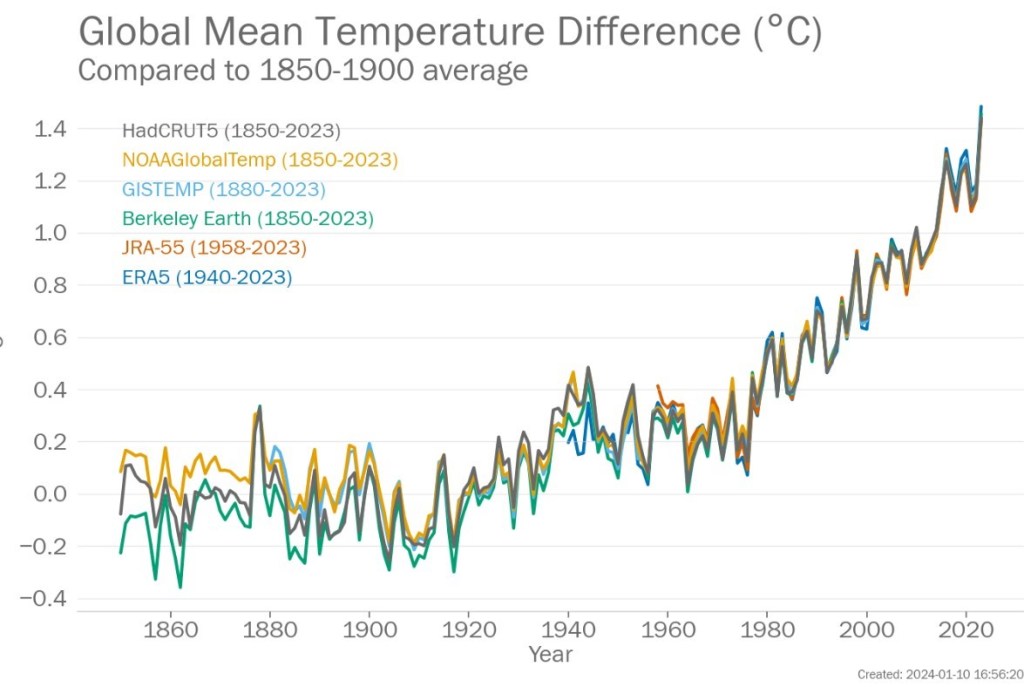The global temperature in 2023 hit 1.45 ± 0.12 °C—the hottest year on record, according to the World Meteorological Organization (WMO) in its Jan. 12 news release.
The years 2016 (which had a strong El Niño) and 2020 were previously classed as the warmest on record at 1.29 ±0.12°C and 1.27 ±0.12°C, respectively, above the pre-industrial era (1850-1900).
The WMO says the 2023 temperature record is symbolic as it is close to the 1.5oC above pre-industrial level limit set by the Paris Agreement, the legally binding international treaty on climate change
Each decade has been warmer than the previous one since the 1980s. The past nine years have been the warmest on record. Based on the six datasets used by the WMO, the average for the period 2014-2023 was 1.20 ±0.12°C above the 1850-1900 average, factoring in a margin of uncertainty.
Per the WMO, record-high temperatures were recorded in the months of June to December, which set a new monthly record. July and August were the two hottest months on record.
“The shift from cooling La Niña to warming El Niño by the middle of 2023 is clearly reflected in the rise in temperature from last year,” said WMO Secretary-General Celeste Saulo.
“Given that El Niño usually has the biggest impact on global temperatures after it peaks, 2024 could be even hotter,” added Saulo, who took office on Jan. 1 to become the first woman and the first South American to head the WMO.
Human activities
But the extreme weather is not just because of El Niño.
“While El Niño events are naturally occurring and come and go from one year to the next, longer-term climate change is escalating and this is unequivocally because of human activities,” said Saulo.
The WMO news release includes the statement of UN Secretary-General António Guterres that issued the same warning: “Humanity’s actions are scorching the earth. 2023 was a mere preview of the catastrophic future that awaits if we don’t act now. We must respond to record-breaking temperature rises with path-breaking action.”
Saulo also stressed the urgency for action: “Climate change is the biggest challenge that humanity faces. It is affecting all of us, especially the most vulnerable.
“We cannot afford to wait any longer. We are already taking action but we have to do more and we have to do it quickly. We have to make drastic reductions in greenhouse gas emissions and accelerate the transition to renewable energy sources.”
Considered the largest cause of greenhouse gas emissions and of global climate change are fossil fuels, which are made from decomposing plants and animals found in Earth’s crust. These include coal, oil and natural gas, which are used to generate electricity and energy.
The COP28 statement issued in Dubai last December is considered historic because for the first time after decades of meetings, there is agreement to transition away from the use of fossil fuels.
Devastation and despair
The WMO’s provisional report on the State of the Global Climate 2023, published on Nov. 30, states that 2023 has shattered a number of climate records and “left a trail of devastation and despair.”
Aside from record-high global temperatures, there were record-high greenhouse gas levels, record-high sea level rise, and record-low Arctic sea ice.

The extreme heat in 2023 also helped fuel devastating wildfires, intense rainfall, floods, and rapidly intensifying cyclones that left a trail of destruction, death and huge economic losses.
The socioeconomic impact on food security, displacement and health will be explained in more detail in the WMO’s final State of the Global Climate 2023 report to be issued in March.
The WMO is a specialized agency of the United Nations whose mandate covers weather, climate and water resources. It provides the framework for international cooperation for UN member-states and territories, believing that the weather, climate and water cycle know no national boundaries.
The year 2023 was ranked as the warmest year in all six international datasets used by the WMO to come up with consolidated figures.
These include datasets based on climatological data from observing sites and ships and buoys in global marine networks, developed and maintained by the United States’ National Oceanic and Atmospheric Administration, the US Nasa’s (National Aeronautics and Space Administration) Goddard Institute for Space Studies, the United Kingdom’s Met Office Hadley Centre and the University of East Anglia’s Climatic Research Unit, and the Berkeley Earth group.
The WMO also uses reanalysis datasets from the European Centre for Medium Range Weather Forecasts and its Copernicus Climate Change Service, and the Japan Meteorological Agency.
Read more: Unmasking ‘phantom’ carbon credits in Thailand: A genuine answer to climate change or chimera?



Leave a Reply